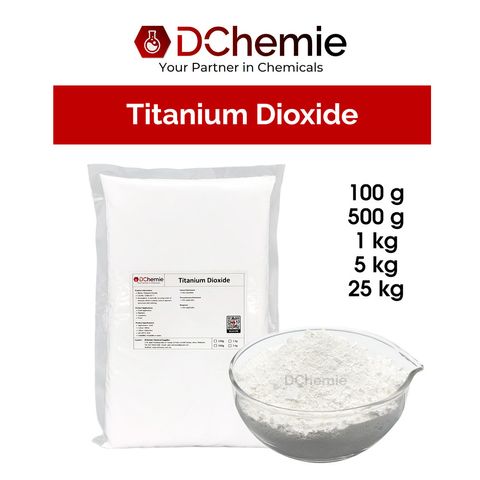
Titanium dioxide (TiO₂) is a naturally occurring oxide of titanium, widely recognized for its brilliant whiteness and excellent light-scattering properties. It is a versatile chemical compound used across numerous industries due to its non-toxic nature, chemical stability, and high refractive index. Naturally present in minerals like rutile, anatase, and brookite, titanium dioxide undergoes extensive processing to achieve the desired purity and form suitable for industrial and commercial applications. Known for its ability to enhance opacity and brightness, it plays a critical role in both aesthetic and functional formulations.
Function and Uses
Titanium dioxide (TiO₂) is a highly versatile compound with many functions across industries. Its unique properties, such as brilliant whiteness, UV protection, and chemical stability, make it essential in various applications:
1. Pigmentation
Titanium dioxide provides exceptional whiteness and opacity, making it a key pigment in paints, coatings, plastics, and paper. It enhances product appearance with a smooth and vibrant finish.
2. UV Protection
Widely used in sunscreens and cosmetics, titanium dioxide reflects harmful UV rays, protecting the skin. In paints and plastics, it prevents degradation caused by sunlight, extending product life.
3. Opacity and Brightness
In food and pharmaceuticals, titanium dioxide adds whiteness and opacity, improving the appearance of products like candies, tablets, and coatings. It also protects sensitive ingredients from light exposure.
4. Photocatalysis
As a photocatalyst, titanium dioxide helps in environmental applications, such as breaking down pollutants in air and water. It is also used in self-cleaning and antimicrobial coatings.
5. Surface Protection
In paints, coatings, and plastics, titanium dioxide improves durability by resisting fading, cracking, and UV damage, ensuring longer-lasting products.
6. Cosmetics and Aesthetics
Titanium dioxide enhances the texture, opacity, and finish of makeup products like foundations and powders while providing sun protection.
Its multifunctional nature ensures titanium dioxide remains essential across industries, improving quality, durability, and sustainability in everyday products.
Applications

Titanium dioxide finds use across a variety of industries. Below are detailed applications and its specific functions in each industry:
1. Paints and Coatings
Titanium dioxide is a key pigment in decorative and industrial paints, providing:
- High opacity for effective coverage.
- Brightness and whiteness for aesthetic appeal.
- Resistance to weathering and UV degradation.
Product Examples: Architectural paints, automotive coatings, industrial finishes.
2. Plastics
In plastics, titanium dioxide improves:
- Durability by offering UV protection.
- Aesthetic quality with enhanced color stability and brightness.
Product Examples: Packaging materials, outdoor furniture, and construction materials.
3. Cosmetics and Personal Care
Titanium dioxide is widely used in products for its:
- UV-blocking properties in sunscreens.
- Whitening and mattifying effects in cosmetics like foundation and powders.
Product Examples: Sunscreen lotions, face powders, and BB creams.
4. Food Industry
As a food additive (E171), titanium dioxide is used to:
- Enhance the appearance of whiteness in products.
- Provide opacity in items like candies, chewing gum, and dairy-based products.
Product Examples: Icing, cream fillings, and coated confectioneries.
5. Pharmaceuticals
Titanium dioxide is included in tablet coatings and capsules to:
- Provide opacity and a professional appearance.
- Protect active ingredients from light degradation.
Product Examples: Coated tablets, gel capsules.
6. Environmental Applications
In photocatalysis, titanium dioxide helps:
- Break down organic pollutants in water and air.
- Create self-cleaning and antimicrobial surfaces.
Product Examples: Water purification systems, antimicrobial tiles, and glass coatings.
7. Paper Industry
Used as a filler and coating pigment, titanium dioxide enhances:
- Opacity and brightness of papers and cardboard.
Product Examples: High-quality printing papers, magazines.
Production/Sources

Titanium dioxide is primarily sourced from natural minerals such as ilmenite and rutile. It is produced using two main processes:
- Sulfate Process: Utilizes sulfuric acid to extract and purify titanium dioxide.
- Chloride Process: Employs chlorine gas and carbon for a more environmentally friendly and efficient method.
The choice of process depends on the raw material availability, desired product quality, and environmental regulations.
Properties/Characteristics
Titanium dioxide exhibits several key characteristics:
- Chemical Formula: TiO₂.
- Appearance: White, powdery solid.
- Density: 4.23 g/cm³ (rutile) and 3.78 g/cm³ (anatase).
- UV Stability: Excellent resistance to UV degradation.
- Non-Toxic: Safe for use in regulated applications.
Conclusion
Titanium dioxide is a highly useful material found in many industries. Its bright white color, ability to reflect light, and UV resistance make it essential for products like paints, plastics, cosmetics, and even food. Safe and versatile, it helps improve the quality, appearance, and durability of everyday items. As industries continue to grow and innovate, titanium dioxide will remain an important ingredient in many applications.






